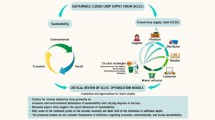Appendix
The average WIP inventories of product i between stage j − 1 and j are calculated by dividing the total of areas I, II, and III in Fig. 1 by the cycle time of product i (k
i
F).
From Fig. 1, we have
$$ v = {{b}_{{ij}}} - {{b}_{{i,j - 1}}} $$
(5)
$$ \matrix{ {w = {{t}_{{i,j - 1}}} - v} \hfill \\ {x = {{t}_{{ij}}} - w} \hfill \\ }<!end array> $$
(6)
$$ x = {{t}_{{ij}}} - {{t}_{{i,j - 1}}} + v $$
(7)
$$ \matrix{ {Y = v{{p}_{{i,j - 1}}}} \hfill \\ {Z = x{{p}_{{ij}}}} \hfill \\ }<!end array> $$
(8)
$$ Z = {{p}_{{ij}}}\left( {{{t}_{{ij}}} - {{t}_{{i,j - 1}}} + v} \right) $$
(9)
The total of areas I, II, and III is calculated as follows:
Area I (triangle 1)
$$ \matrix{ { = 0.5Yv} \hfill \\ { = 0.5{{p}_{{i,j - 1}}}{{{(v)}}^2}} \hfill \\ }<!end array> $$
(10)
Area II (trapezium)
$$ \matrix{ { = 0.5w\left( {Y + Z} \right)} \hfill \\ { = 0.5\left( {{{t}_{{i,j - 1}}} - v} \right)\left\lfloor {v{{p}_{{i,j - 1}}} + \left( {{{t}_{{ij}}} - {{t}_{{i,j - 1}}} + v} \right){{p}_{{ij}}}} \right\rfloor } \hfill \\ }<!end array> $$
(11)
Area III (triangle 2)
$$ \matrix{ { = 0.5Zx} \hfill \\ { = 0.5{{p}_{{ij}}}\left( {{{t}_{{ij}}} - {{t}_{{i,j - 1}}} + v} \right)\left( {{{t}_{{ij}}} - {{t}_{{i,j - 1}}} + v} \right)} \hfill \\ }<!end array> $$
(12)
The total of areas I, II, and III is obtained by summing Eqs. (10), (11), and (12) and is given by
$$ \begin{array}{*{20}{c}} { = 0.5{{p}_{{i,j - 1}}}{{{(v)}}^{2}} + 0.5\left( {{{t}_{{i,j - 1}}} - v} \right)\left[ {v{{p}_{{i,j - 1}}} + \left( {{{t}_{{ij}}} - {{t}_{{i,j - 1}}} + v} \right){{p}_{{ij}}}} \right] + 0.5{{p}_{{ij}}}\left( {{{t}_{{ij}}} - {{t}_{{i,j - 1}}} + v} \right)\left( {{{t}_{{ij}}} - {{t}_{{i,j - 1}}} + v} \right)} \\ { = 0.5\left[ {\begin{array}{*{20}{c}} {{{p}_{{i,j - 1}}}{{v}^{2}} + {{p}_{{i,j - 1}}}{{t}_{{i,j - 1}}}v + {{p}_{{ij}}}{{t}_{{ij}}}{{t}_{{i,j - 1}}} - {{p}_{{ij}}}{{{\left( {{{t}_{{i,j - 1}}}} \right)}}^{2}} + {{p}_{{ij}}}{{t}_{{i,j - 1}}}v - {{p}_{{i,j - 1}}}{{v}^{2}} - {{p}_{{ij}}}{{t}_{{ij}}}v + {{p}_{{ij}}}{{t}_{{i,j - 1}}}v - } \hfill \\ {{{p}_{{ij}}}{{v}^{2}} + {{p}_{{ij}}}{{{\left( {{{t}_{{ij}}}} \right)}}^{2}} - {{p}_{{ij}}}{{t}_{{ij}}}{{t}_{{i,j - 1}}} + {{p}_{{ij}}}{{t}_{{ij}}}v - {{p}_{{ij}}}{{t}_{{ij}}}{{t}_{{i,j - 1}}} + {{p}_{{ij}}}{{{\left( {{{t}_{{i,j - 1}}}} \right)}}^{2}} - {{p}_{{ij}}}{{t}_{{i,j - 1}}}v + {{p}_{{ij}}}{{t}_{{ij}}}v - {{p}_{{ij}}}{{t}_{{i,j - 1}}}v + } \hfill \\ {{{p}_{{ij}}}{{v}^{2}}} \hfill \\ \end{array} } \right]} \\ { = 0.5\left[ {{{p}_{{i,j - 1}}}{{t}_{{i,j - 1}}}v + {{p}_{{ij}}}{{{\left( {{{t}_{{ij}}}} \right)}}^{2}} - {{p}_{{ij}}}{{t}_{{ij}}}{{t}_{{i,j - 1}}} + {{p}_{{ij}}}{{t}_{{ij}}}v} \right]} \\ { = 0.5\left[ {{{p}_{{i,j - 1}}}{{t}_{{i,j - 1}}}v + {{p}_{{ij}}}{{t}_{{ij}}}\left( {{{t}_{{ij}}} - {{t}_{{i,j - 1}}} + v} \right)} \right].} \\ \end{array} $$
(13)
Note that t
i,j − 1 and t
ij
are the production length at stage j − 1 and j, respectively. Those values can be obtained by dividing the demand over the cycle length (the demand rate (d
i
) times the cycle time (k
i
F)) by the production rate at the corresponding stages.
$$ {{t}_{{i,j - 1}}} = {{d}_i}{{k}_i}F/{{p}_{{i,j - 1}}} $$
(14)
$$ {{t}_{{ij}}} = {{d}_i}{{k}_i}F/{{p}_{{ij}}} $$
(15)
Hence, substituting Eqs. (5), (14), and (15) to Eq. (13) yields
$$ \matrix{ { = 0.5\left[ {{{d}_i}{{k}_i}F\left( {{{b}_{{ij}}} - {{b}_{{i,j - 1}}}} \right) + {{d}_i}{{k}_i}F\left( {{{d}_i}{{k}_i}F/{{p}_{{ij}}} - {{d}_i}{{k}_i}F/{{p}_{{i,j - 1}}} + {{b}_{{ij}}} - {{b}_{{i,j - 1}}}} \right)} \right]} \hfill \\ { = 0.5\left[ {2{{d}_i}{{k}_i}F\left( {{{b}_{{ij}}} - {{b}_{{i,j - 1}}}} \right) + {{{\left( {{{d}_i}{{k}_i}F} \right)}}^2}\left( {1/{{p}_{{ij}}} - 1/{{p}_{{i,j - 1}}}} \right)} \right].} \hfill \\ }<!end array> $$
(16)
Dividing the total area in Eq. (16) by the cycle time (k
i
F) returns the average WIP between stage j − 1 and j which is expressed as in Eq. (17).
$$ {{I}_{{i,j - 1}}} = {{d}_i}\left[ {\left( {{{b}_{{ij}}} - {{b}_{{i,j - 1}}}} \right) + 0.5{{d}_i}{{k}_i}F\left( {1/{{p}_{{ij}}} - 1/{{p}_{{i,j - 1}}}} \right)} \right] $$
(17)
Hence, the WIP-holding cost between two stages for all items (n) and all stages (m) is then:
$$ {\text{T}}{{{\text{C}}}_{{{\text{WIP}}}}} = \sum\nolimits_{{i = 1}}^{n} {\sum\nolimits_{{j = 2}}^{m} {{{h}_{{i,j - 1}}}{{d}_{i}}\left[ {\left( {{{b}_{{ij}}} - {{b}_{{i,j - 1}}}} \right) + 0.5{{d}_{i}}{{k}_{i}}F\left( {1/{{p}_{{ij}}} - 1/{{p}_{{i,j - 1}}}} \right)} \right]} } . $$
(18)




